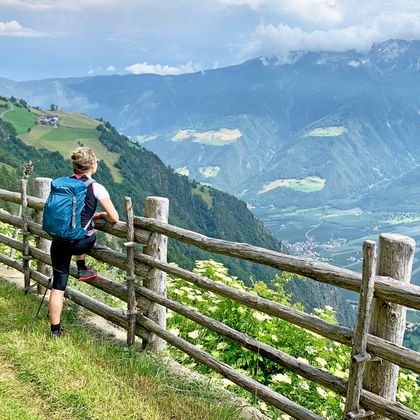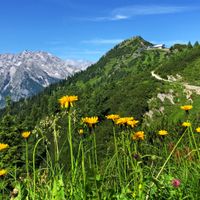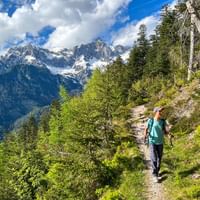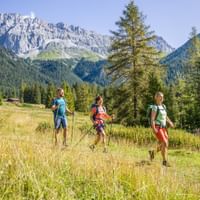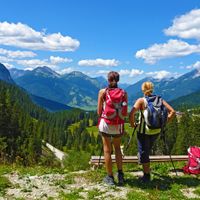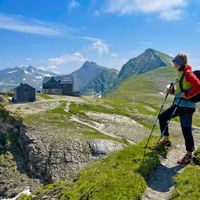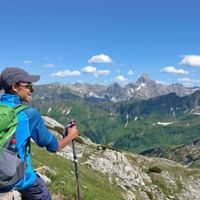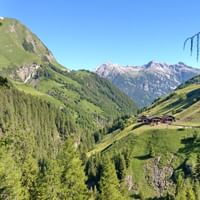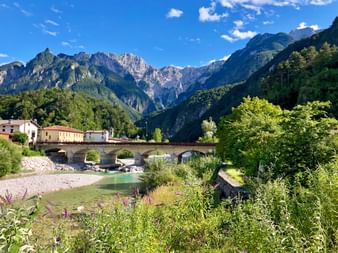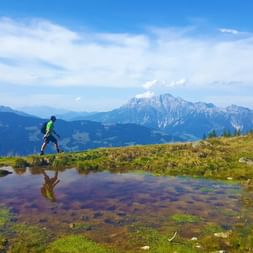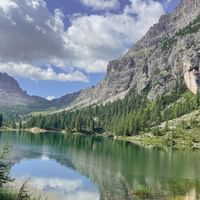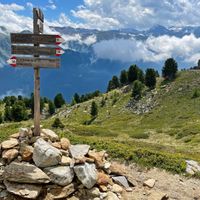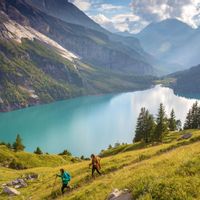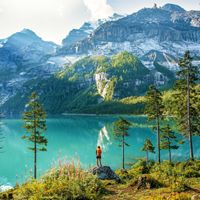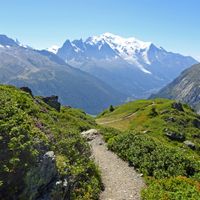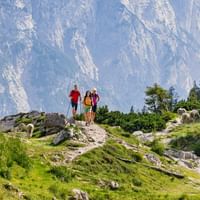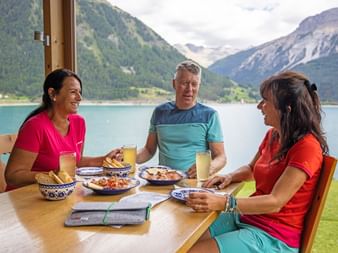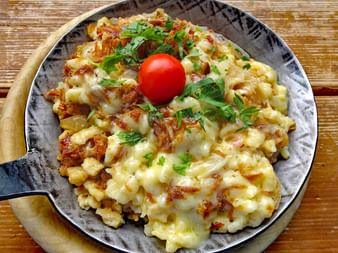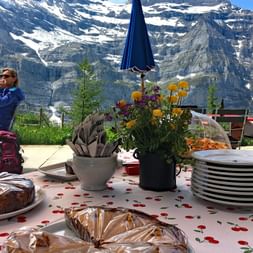Basic information about the Alpine region
The magic of walking spurs you on along our hiking tours in the Alpine region. With a total area of around 200,000 km², the Alpine region offers a diverse selection of multi-faceted hikes for all levels of hiking. The Alps, which are also the highest mountains in the interior of Europe, extend over a length of around 1,200 kilometres from the Ligurian Sea to the Pannonian Basin. The Alpine regions include a total of eight countries, also known as Alpine states: Austria, Germany, Italy, Switzerland, France, Liechtenstein, Slovenia and Monaco. In six of these countries, we at Eurohike offer organized hiking tours with luggage transfer. So you can enjoy your active experience completely carefree, without any weight on your back and foregoing any comfort in the evening.
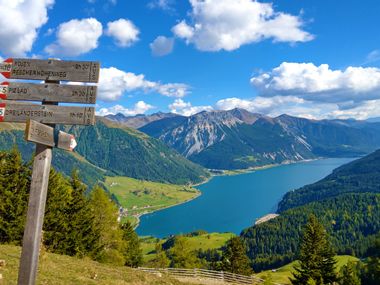
The most beautiful tours in the Alpine region
Alpine crossing by Eurohike
Crossing the Alps is only something for experienced and trained mountaineers? On our hiking tours, crossing the Alps is a pleasurable active experience for every energy level. Experience three alpine states and countless hiking experiences between Munich and Venice on one of our four individual hiking tours. You can experience these individually or all four at once, depending on your skill level, time and motivation.
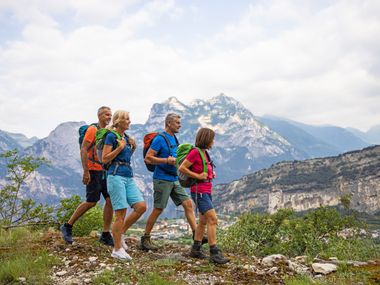
Austrian Alps
Salzburg’s Peaks & Kitzbühel Alps
On our hiking holiday Salzburg’s Peaks & Kitzbühel Alps, 8 days you will be impressed anew every day by the imposing mountain backdrops and landscapes. The Austrian Alps and their highest peaks accompany you on this tour. After a successful day’s hike, you will be rewarded with the best culinary treasures of the Pinzgau regions. As a shorter variant, the mountain hiking holiday Salzburg’s Peaks & Kitzbühel Alps, 5 days, is the ideal high-altitude hike in the Alps in Austria.
Bavarian & Salzburg Alps
Experience endless outdoor fun on the mountain hiking holiday Bavarian & Salzburg Alps, 8 days. Because on this active holiday you can enjoy the two alpine landscapes in Bavaria and Salzburg. Over eight days the route takes you from Schönau am Königssee via Dienten am Hochkönig to Golling in Austria and back to the Königssee.
- More information and details about the hiking holidays in the Bavarian Alps at a glance.
Hohe Tauern National Park
High up, between peaks and glaciers, the Hohe Tauern National Park unfolds with the most beautiful Alpine panoramas of the Pinzgau region. On this 8-day hiking tour, you will experience varied daily stages with picturesque alpine pastures, clear mountain lakes and the unspoilt nature of the Alps. Whether you enjoy the tranquillity of the Alps or take on the challenges of the hikes - this national park offers the perfect adventure for every hiking enthusiast.
German Alps
Around Zugspitze
A hiking holiday around the Zugspitze, Germany’s highest mountain, should be on the wish-list of every hiking fan. Starting from Garmisch-Partenkirchen, the route of our hiking holiday Around Zugspitze, 7 days takes you around the 2,962 metre-high mountain, past beautiful alpine meadows, through gorges to the Leutasch valley and back to the starting point of the journey. Experience even more enjoyment and comfort on our hiking holiday Around Zugspitze with charm, 7 days.
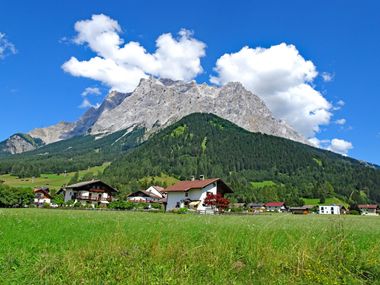
From Lake Königssee to Lake Wörthersee
Eight days, six hiking stages, diverse hiking and mountain trails past idyllic alpine pastures and pristine alpine lakes – you will experience this and much more on our mountain hiking holiday from Lake Königssee to Lake Wörthersee, 8 days. From Schönau am Königssee you first walk to Weißbach and Dienten am Hochkönig, then on to Bad Gastein and Mallnitz to Obervellach and to the final stage destination of Döbriach am Millstätter See in Carinthia. Our mountain hiking holiday from Lake Königssee to Lake Wörthersee, 10 days, offers even more hiking fun.

Crossing the Alps E5: Oberstdorf - Meran
If you are looking for a unique trekking tour that leads along impressive mountain trails from the Bavarian Allgäu to South Tyrol, our hiking holiday Crossing the Alps E5: Oberstdorf – Meran is the right choice. This hiking tour of the level of hiking 'trekking' takes you on the European long-distance hiking trail E5 from Oberstdorf in Bavaria to Meran in South Tyrol. You will experience the most beautiful places in the region, impressive waterfalls, mountain passes, alpine landscapes and mountain areas by foot. The first two daily stages lead in the high alpine area, the following tours can be replaced by a more comfortable valley option if desired.
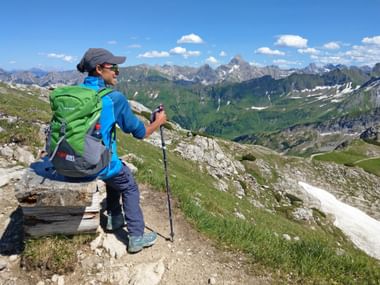
Italian Alps
Dolomite Alps – Nature park walking tour
Experience an unforgettable active adventure in Italy on our walking holiday Dolomite Alps – Nature park walking tour, 8 days. Over six stages you hike on well-marked mountain paths and hiking trails in the Italian Alps and explore the UNESCO World Heritage Site of the Dolomites. Our tip: do not miss the unique mountain range and dreamlike nature park of the Three Peaks on a hike in the Puster valley in South Tyrol.
Dolomite High Routes
You will experience an equally unforgettable mountain experience in the Italian Alps on our mountain hiking holiday Dolomite High Routes, 7 days. With a good basic level of fitness, this hiking holiday is pure enjoyment in the middle of the Dolomites for real mountain lovers. You hike from Villabassa first to St. Vigil and Badia, on to St. Kassian and finally to the Falzarego Pass in Balluno before returning to the starting point of your trip in Villabassa on the last day.
Panorama Hiking in the Vinschgau
On our walking holiday Panorama Hiking in the Vinschgau, 8 days you will experience the most beautiful hiking routes and unique mountain panoramas in South Tyrol. You will always be accompanied by wonderful views of the high mountains and enjoy all that the beautiful region in Vinschgau has to offer. Embark on an unforgettable hiking tour from Mals to Burgeis and back to the starting point of your active trip to Mals.
From the Alps to the Adriatic Sea
Your eight-day hiking tour from the Alps to the Adriatic Sea starts in Tarvis, a picturesque mountain village, and takes you first to the pilgrimage site of Monte Lussari. It continues via Venzone and Monte Cumieli to Gemona, where the historic Centro Storico with magnificent palazzi, arcades and frescoes is just waiting to be explored by you. Picturesque Udine offers museums, art galleries, typical Italian café bars and numerous shopping opportunities. The route leads through the Collio vineyards to Gradisca d'Isonzo and ends in the port city of Trieste. The perfect end to your trip is the round trip with breathtaking views of Trieste and Slovenia - a wonderful active break in Friuli-Venezia Giulia.
Swiss Alps
Via Alpina „Bear Trek“
For all mountain hikers our trekking-tour Via Alpina „Bear Trek“, 8 days is definitely the ideal active experience in Switzerland. You will probably not meet any more bears in the wild on your trekking tour, but this hiking trail owes its name to the wild animals that you could encounter on this route a long time ago. Today you can expect imposing glacier worlds and an alpine mountain adventure that you will remember for a long time. Experience extra special comfort on our trekking-tour Via Alpina „Bear Trek“ with Charm, 8 days
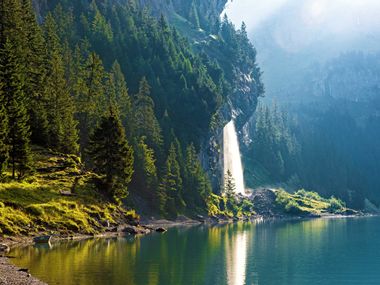
French Alps
Tour du Mont Blanc
Are you ready for an unforgettable hiking adventure in the Alps? The Tour du Mont Blanc offers spectacular peaks, wide valleys, and an incredible mountain landscape that you can experience up close. This twelve-day journey takes you through three countries and lets you summit some of Europe's most famous peaks. A true highlight for trekking enthusiasts and a challenge for your endurance. Get ready for a truly special adventure!
Tour du Mont Blanc, Highlights
Experience the beauty of the Alps on the Tour du Mont Blanc, Highlights. This challenging hiking tour takes you through France, Italy, and Switzerland, offering breathtaking views of Mont Blanc, Lake Miage, and the mountaineering town of Courmayeur. Over the course of eight days, you'll hike through stunning mountain landscapes and discover idyllic valleys. An unforgettable challenge for hikers with good fitness and surefootedness.
Slovenian Alps
Julian Alps & Wild Soča Valley
The Julian Alps & Wild Soča Valley are a paradise for nature lovers. On our hiking holiday in Slovenia, you will experience the untouched beauty of this region with crystal-clear mountain streams and majestic peaks. Look forward to varied daily stages and impressive views in one of Europe’s most fascinating hiking regions.
Alpe-Adria-Trail: Kranjska Gora - Cividale
The Alpe-Adria Trail from Kranjska Gora to Cividale combines alpine landscapes with cultural highlights. From the Triglav mountains, the route leads over the Vršič Pass to the source of the Soča, then through the valley with its turquoise river, suspension bridges, and waterfalls. Across alpine meadows and the Kolovrat ridge, you finally reach Cividale, where a Mediterranean atmosphere meets a historic setting.
Useful information about your hiking holiday in the Alpine region
Facts and details
- Location of the Alpine region: Austria, Germany, Italy, France, Switzerland, Slovenia, Monaco, Liechtenstein
- Division of the Alpine region: On the basis of historical and geographical agreements, the Alps can be divided into the Eastern and Central Alps (Austria, Germany, Switzerland, Italy, Slovenia, Liechtenstein) and the Western Alps (France, Italy, Switzerland, Monaco)
- Area: 200,000 km2
- Highest mountain: Mont Blanc with a height of 4,810 metres
- Season: The best climate for hiking tours in the Alpine region is different and depends on the country and altitude of the respective hiking tour
- Target groups: The hiking routes in the Alpine region offer a successful active adventure for all levels of hiking from leisurely panoramic hikes to demanding trekking tours.
- Special feature: Highest mountains in the interior of Europe and living and recreation area for around 13 million people.
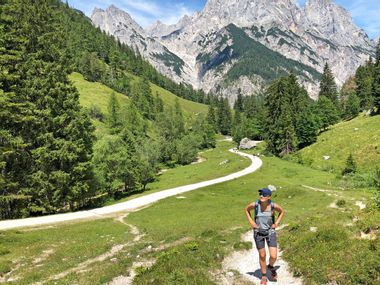
Climate in the Alpine region
The Alpine arc extends over a total of 1,200 kilometres. So it isn’t surprising that climatic conditions can vary depending on the Alpine state and region. The Alps are considered to be one of the most important climatic divisions in Europe and subdivide the following climatic provinces: the Atlantic, the Pannonian climatic province and the Mediterranean climatic area. In the northern Alps, the climate is very similar to that in the neighbouring flatlands, whereas in the southern Alpine areas there are Mediterranean climatic conditions with mild winter months and hot summer periods. The eastern areas in the Alps are characterized by a continental-Panonnian wine-growing climate and the inner-Alpine valleys such as the Vinschgau, Carinthia or Valais are dry. The most important influences are the mild westerly winds with humid air masses from the Atlantic, the cool polar air from the north, the dry continental air masses from the eastern areas, as well as the warmer, southern currents.

Culture and tradition in the Alps
It took a while until the Alpine region was officially designated as a mountain range. Only in autumn of 218 BC when Hannibal accomplished the feat of marching across the Alps in 16 days did they gain attention. The cultural and religious traditions rooted in the Alps to this day go far back in history. Back then it was important for people to protect themselves from possible dangers of nature and from demons. This is how numerous legends and traditional stories emerged. In the early Middle Ages, the Alpine region established itself as the border between the language and culture of the Germanic language to the north and the Romance language to the south and west, and numerous dialects emerged. Although only a few have survived to this day, these small alpine languages are still used: Graubünden Romance in Graubünden in Switzerland, Dolomite Ladin in the Dolomites and Friulian in the Italian region of Friuli-Venezia Giulia. The rural customs played a particularly important role in the Alpine region and so numerous traditions such as the cattle drive, yodeling and alpine folk music are still lived today.

Alpine cuisine
In culinary terms, the Alpine cuisine can also boast a variety of traditional recipes and numerous regional influences. As a real cultural asset, alpine cuisine is shaped by everyday rural life in the remote mountain villages and alpine pastures. Even then, it was important to pay attention to foods that could be produced directly on the farm and have a long shelf life, such as milk and grain products, as well as dried or smoked meat. Due to the wide expanse of the Alpine region, the dishes are also strongly influenced by the cuisine of the respective region.
On a culinary journey through the Alps, you can find Emmental cow’s milk cheese in Switzerland, bacon from Tyrol or South Tyrol, dried meat from the Swiss canton of Valais, Bavarian sauerkraut in Germany, the best types of wine from South Tyrol or pine schnapps from Austria. It was particularly important for mountain farmers and shepherds to eat a diet rich in carbohydrates in order to have enough strength for the physically demanding work on the alpine pastures. Bread, pasta and pastries such as Buchteln or Schlutzkrapfen were an important part of Alpine cuisine and are still popular today.
